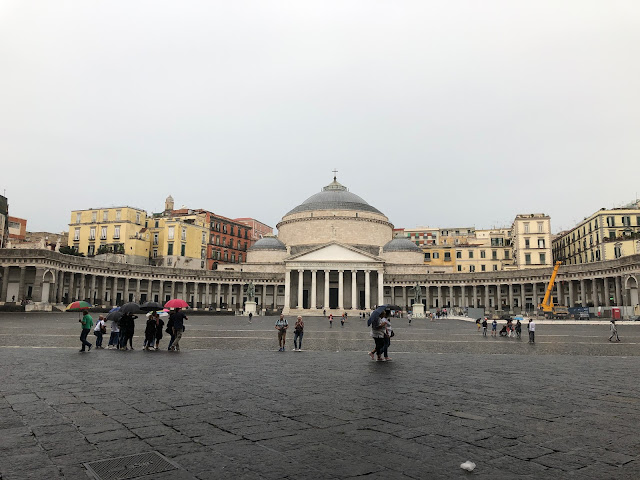【ナポリ】プレビシート広場 Napoli - Piazza del Plebiscito
王宮の目の前には、ナポリで一番大きな広場と言われる、広大なプレビシート広場が広がっている。
たった今、見学し終わった王宮は、17世紀の初頭に作られたが、その前にはこの広場の左奥辺りに、スペイン・ハプスブルグ家支配時代のナポリ総督が1543年に作らせた、総督の館があった。
この広場の奥には、1846年にローマのパンテオンに似せて作られた新古典様式の巨大な聖堂が立っている。
その手間には、ナポリをバロック都市に作り変えたスペイン・ブルボン家のカルロス7世と、その子、フェルディナンド1世の騎馬像が立っている。
いずれも、アントニオ・カノーヴァの作品だが、当初はナポレオン像が作られる予定だったが、ナポレオンが失脚して、フェルディナンド1世がナポリ王に返り咲いて、自分と父親の騎馬像を作らせた。
その後、イタリア統一運動の最中、この広場で統一の賛否を問う国民投票が行われた。
それが理由で、この広場は、国民投票を意味する、プレビシート広場という名前になった。
この広場には、そうしたナポリの歴史の記憶が刻まれている。
In front of the Royal Palace lies the Piazza del Plebiscito, the largest square in Naples.
The Royal Palace, which we have just finished visiting, was built in the early 17th century. There was a mansion.
At the far end of this square stands a huge neoclassical cathedral built in 1846 to resemble the Pantheon in Rome.
Between them stands the equestrian statue of Carlos VII of Spain, who transformed Naples into a baroque city, and his son, Ferdinando I of Bourbon.
Both are works by Antonio Canova, but the original plan was to make a statue of Napoleon, but after Napoleon's downfall, Ferdinand I returned to the King of Naples and had him and his father made on horseback. .
Later, in the midst of the Italian unification movement, a referendum was held in this square to ask whether or not to unify Italy.
That is why the square got the name Plebiscito Square, which means referendum.
This square is engraved with the memory of Naples' history.



コメント
コメントを投稿